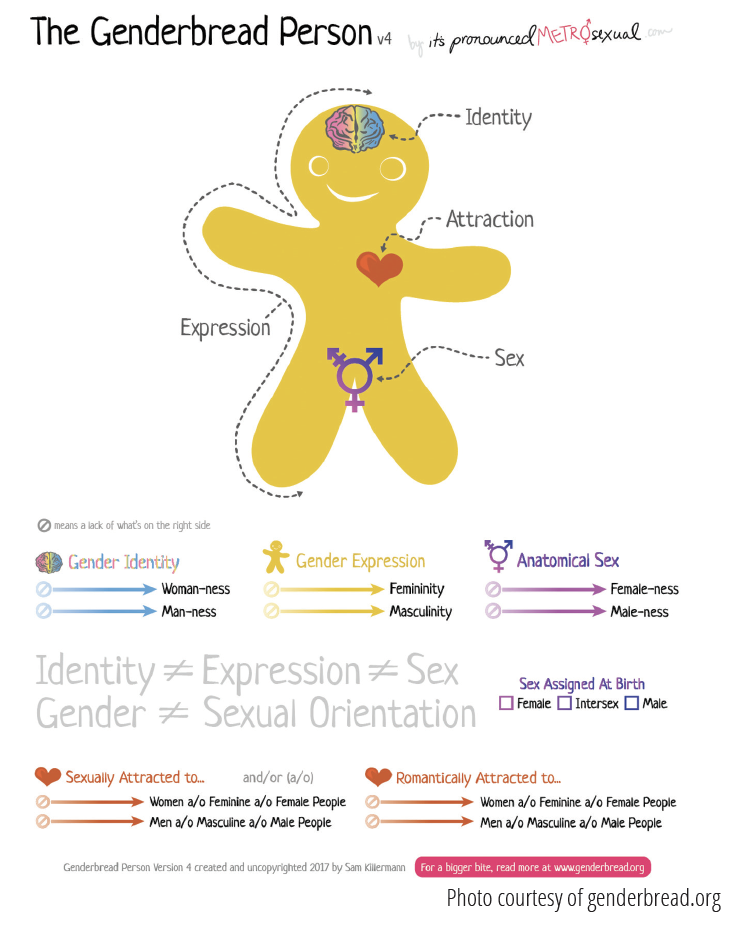GENDERFLUIDITY: WHAT DOES IT MEAN AND HOW DOES IT WORK?
by Artemis Hamrick (she/they), Parent
Chelsie Holmes (she/her), Yampa Valley Pride
Sylvie Piquet (she/her)

GENDERFLUIDITY
WHAT DOES IT MEAN AND HOW DOES IT WORK?
by Artemis Hamrick (she/they), Parent
Chelsie Holmes (she/her), Yampa Valley Pride
Sylvie Piquet (she/her)
THE YAMPA VALLEY community is home to people who are transgender, lesbian, nonbinary, queer, intersex, gay, two-spirit, asexual, bisexual and beyond! But what does that even mean? Over the past decade, gender has become fluid and new expressions and vocabularies for gender and sexuality have not only become more accepted, but are ways in which people identify themselves. Defined identities can help others become more accepting and inclusive of all people.
Identity is made up of a variety of factors, unique to each being. For some, place of origin is a more prominent part of identity; for others gender is a strong part of how a being identifies; for some, religion is very central; and for others sexual orientation is weighted heavily. Everyone has multiple identities. The identities that are challenged most often become those central to who we are because they require greater attention.
We are learning, as a culture, about the differences between gender and sexuality as two different parts of identity that we each have. We are learning about the spectrum of sexuality as well as the spectrum of gender. Sexuality is not two or three identities; it is a spectrum made up of physical attraction and romantic attraction with infinite combinations. Gender is also a spectrum. There are not only two genders. There is a whole array of gender identities, including nonbinary, transgender, female, abinary, male, genderqueer and beyond! Just like all LGBTQIA2S+ people, nonbinary people have always existed.
New terms can be overwhelming, especially when they are breaking down what we once considered to be true: For example, if a person’s biological sex at birth is female, that person’s gender was considered female. There is now greater understanding that this is not the case. Let’s take a look at the difference between gender and sexuality. The genderbread person exemplifies this well:
The genderbread image demonstrates the layers of gender identity (inward), gender expression (outward), sexual orientation and romantic sexual attraction. These are all pieces of each individuals’ identity that are interacting.
TERMINOLOGY
Once there is an understanding of the difference between gender and sexuality and biological sex (which does not determine gender or sexuality), it’s time to roll up our sleeves and learn how to use terms that are now more common.
LGBTQIA2S+ can feel like an alphabet soup to the untrained eye. And, yet, this expanding acronym describes sexuality and gender queer community. The acronym continues to evolve in an effort to include those who have been traditionally marginalized within the queer community. LGBTQIA2S+ stands for lesbian, gay, bisexual (three sexual orientation identities), transgender (gender identity), queer (could refer to sexuality or gender), intersex (a variety of situations when someone is born with reproductive or sexual anatomy that does not align with the artificial dichotomy of male or female), asexual (sexual orientation), two-spirit (an indigenous term for someone who has both masculine and feminine spirit), and “+” which includes all of the genders and sexualities not described here. For example, pansexual is the sexual orientation of one of the article authors. While she identities as part of the LGBTQIA2S+ community, her sexual orientation is not explicitly part of the acronym; however, pansexual is included in the ‘+’ and ‘Q’.
Now, consider pronouns. Pronouns are those little words that we use to refer to someone instead of using their name. There are many options for pronouns. It’s okay if you are not familiar with all of them. You may encounter they/them, ze/zirs, she/hers, he/they, he/his, but using a pronoun correctly does not require you to be familiar with that pronoun. All it takes is an open heart and an open mind. Steamboat Springs middle school and high school students, emphatically agreed that if you don’t know someone’s pronouns, just ask! It can feel uncomfortable if you’re not used to asking someone’s pronouns, but it is much more uncomfortable for the person being mis-pronouned than for the person asking.
How does it feel when someone calls a person by the wrong name or mispronounces a name? How does it feel when someone does it repeatedly?
Let’s hear from Steamboat Springs middle school and high school students:
How does it feel to hear people use your correct pronouns?
Student 1: “It feels normal. This should be the norm, the lowest expectation to support trans people.”
Student 2: “It makes me feel valid and like people care about who I am. I know that changing pronouns is a shift for people in the beginning, but having family and friends that will always try to use my pronouns even if it means correcting themselves, feels really good.”
How does it feel when people use the wrong pronouns?
Student 1: “When someone uses the wrong pronouns, it doesn’t really make me feel valid.”
Student 2: “It depends on the situation but, usually, frustrated or disappointed.”
What can people do to make you feel safe to be yourself?
Student 1: “People asking me to introduce myself with my pronouns and name always feels more inclusive to me.”
TIPS FOR INCREASING INCLUSION AND BELONGING
Offer a sense of belonging by calling someone by the name and pronouns with which they identify. Culturally, we are able to rename someone after marriage when their last name changes. Try applying this frame of mind when you learn someone now goes by a different first name.
We used to show respect with ‘Mr.’ and ‘Mrs’. Now we show respect by introducing ourselves with our own pronouns or asking someone their pronouns rather than assuming. What if you come across a pronoun you have never heard before? That’s okay—just use it. You don’t need to understand or feel comfortable with someone’s identity to be respectful. Recognize that as a human you have more in common with this person than not. We all want to belong. AH CH SP
Photo

We looked it up for you.
Thanks Mirriam-Webster Dictionary!
ASEXUAL: not involving, involved with, or relating to sex : devoid of sexuality. : not having sexual feelings toward others : not experiencing sexual desire or attraction
BINARY: something made of two things or parts
BISEXUAL: of, relating to, or characterized by sexual or romantic attraction to people of one’s same sex and of the opposite sex
CISGENDE: of, relating to, or being a person whose gender identity corresponds with the sex the person had or was identified as having at birth
GAY: of, relating to, or characterized by sexual or romantic attraction to people of one’s same sex
GENDERFLUID: of, relating to, or being a person whose gender identity is not fixed. Gender-fluid individuals prefer to remain flexible about their gender(s). Some dress in ways that reflect both genders at the same time, while others may express one gender one day and another gender another day.— Kristin Cronn-Mills
GENDERQUEER: of, relating to, or being a person whose gender identity cannot be categorized as solely male or female
HE/THEY: Someone who alternates between pronouns
INTERSEXUALITY: the condition (such as that occurring in congenital adrenal hyperplasia or androgen insensitivity syndrome) of either having both male and female gonadal tissue in one individual or of having the gonads of one sex and external genitalia that is of the other sex or is ambiguousIntersexuality, in a variety of forms, occurs in about one of every 2,000 births—about the same proportion as cystic fibrosis.— Emily Nussbaum
LESBIAN: a woman who is sexually or romantically attracted to other women
NONBINARY: relating to or being a person who identifies with or expresses a gender identity that is neither entirely male nor entirely female
PANSEXUAL: of, relating to, or characterized by sexual or romantic attraction that is not limited to people of a particular gender identity or sexual orientation
QUEER: of, relating to, or characterized by sexual or romantic attraction that is not limited to people of a particular gender identity or sexual orientation
TRANSGENDER: of, relating to, or being a person whose gender identity differs from the sex the person had or was identified as having at birth
TWO SPIRIT: refers to a person who identifies as having both a masculine and a feminine spirit, and is used by some Indigenous people to describe their sexual, gender and/or spiritual identity – from lgbtqhealth.ca
PRONOUNS
MX: Used as a gender-neutral title of courtesy (Similar to Mr. or Miss)
THEY/THEM: Used by nonbinary genders
ZE/ZIRS: Used by some transgender, non-binary or gender non-conforming people
